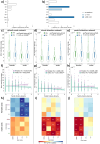This is a preprint.
Sex-specific differences in brain activity dynamics of youth with a family history of substance use disorder
- PMID: 39282344
- PMCID: PMC11398379
- DOI: 10.1101/2024.09.03.610959
Sex-specific differences in brain activity dynamics of youth with a family history of substance use disorder
Abstract
An individual's risk of substance use disorder (SUD) is shaped by a complex interplay of potent biosocial factors. Current neurodevelopmental models posit vulnerability to SUD in youth is due to an overreactive reward system and reduced inhibitory control. Having a family history of SUD is a particularly strong risk factor, yet few studies have explored its impact on brain function and structure prior to substance exposure. Herein, we utilized a network control theory approach to quantify sex-specific differences in brain activity dynamics in youth with and without a family history of SUD, drawn from a large cohort of substance-naïve youth from the Adolescent Brain Cognitive Development Study. We summarize brain dynamics by calculating transition energy, which probes the ease with which a whole brain, region or network drives the brain towards a specific spatial pattern of activation (i.e., brain state). Our findings reveal that a family history of SUD is associated with alterations in the brain's dynamics wherein: i) independent of sex, certain regions' transition energies are higher in those with a family history of SUD and ii) there exist sex-specific differences in SUD family history groups at multiple levels of transition energy (global, network, and regional). Family history-by-sex effects reveal that energetic demand is increased in females with a family history of SUD and decreased in males with a family history of SUD, compared to their same-sex counterparts with no SUD family history. Specifically, we localize these effects to higher energetic demands of the default mode network in females with a family history of SUD and lower energetic demands of attention networks in males with a family history of SUD. These results suggest a family history of SUD may increase reward saliency in males and decrease efficiency of top-down inhibitory control in females. This work could be used to inform personalized intervention strategies that may target differing cognitive mechanisms that predispose individuals to the development of SUD.
Keywords: adolescence; brain activity dynamics; family history; network control theory; neuroimaging; sex differences; substance use disorder.
Figures





Similar articles
-
Reward Processing in Drug-Naive Youth with Various Levels of Risk for Substance Use Disorders: A Pilot Study.J Child Adolesc Psychopharmacol. 2019 Aug;29(7):516-525. doi: 10.1089/cap.2018.0175. Epub 2019 Jun 10. J Child Adolesc Psychopharmacol. 2019. PMID: 31180232 Free PMC article.
-
Reward-Based Learning as a Function of Severity of Substance Abuse Risk in Drug-Naïve Youth with ADHD.J Child Adolesc Psychopharmacol. 2018 Oct;28(8):547-553. doi: 10.1089/cap.2018.0010. Epub 2018 Jun 20. J Child Adolesc Psychopharmacol. 2018. PMID: 29924634 Free PMC article.
-
White matter integrity and functional connectivity in adolescents with a parental history of substance use disorder.Neuroimage Rep. 2021 Sep;1(3):100037. doi: 10.1016/j.ynirp.2021.100037. Epub 2021 Jul 22. Neuroimage Rep. 2021. PMID: 36320407 Free PMC article.
-
Similarity and difference in large-scale functional network alternations between behavioral addictions and substance use disorder: a comparative meta-analysis.Psychol Med. 2024 Feb;54(3):473-487. doi: 10.1017/S0033291723003434. Epub 2023 Dec 4. Psychol Med. 2024. PMID: 38047402 Review.
-
Sex Differences in Substance Use Disorders: A Neurobiological Perspective.Front Glob Womens Health. 2021 Dec 8;2:778514. doi: 10.3389/fgwh.2021.778514. eCollection 2021. Front Glob Womens Health. 2021. PMID: 34957467 Free PMC article. Review.
References
-
- Substance Abuse and Mental Health Services Administration. Key substance use and mental health indicators in the United States: Results from the 2021 National Survey on Drug Use and Health (HHS Publication No. PEP22-07-01-005, NSDUH Series H-57). Center for Behavioral Health Statistics and Quality, Substance Abuse and Mental Health Services Administration. (2022).
Publication types
Grants and funding
LinkOut - more resources
Full Text Sources
